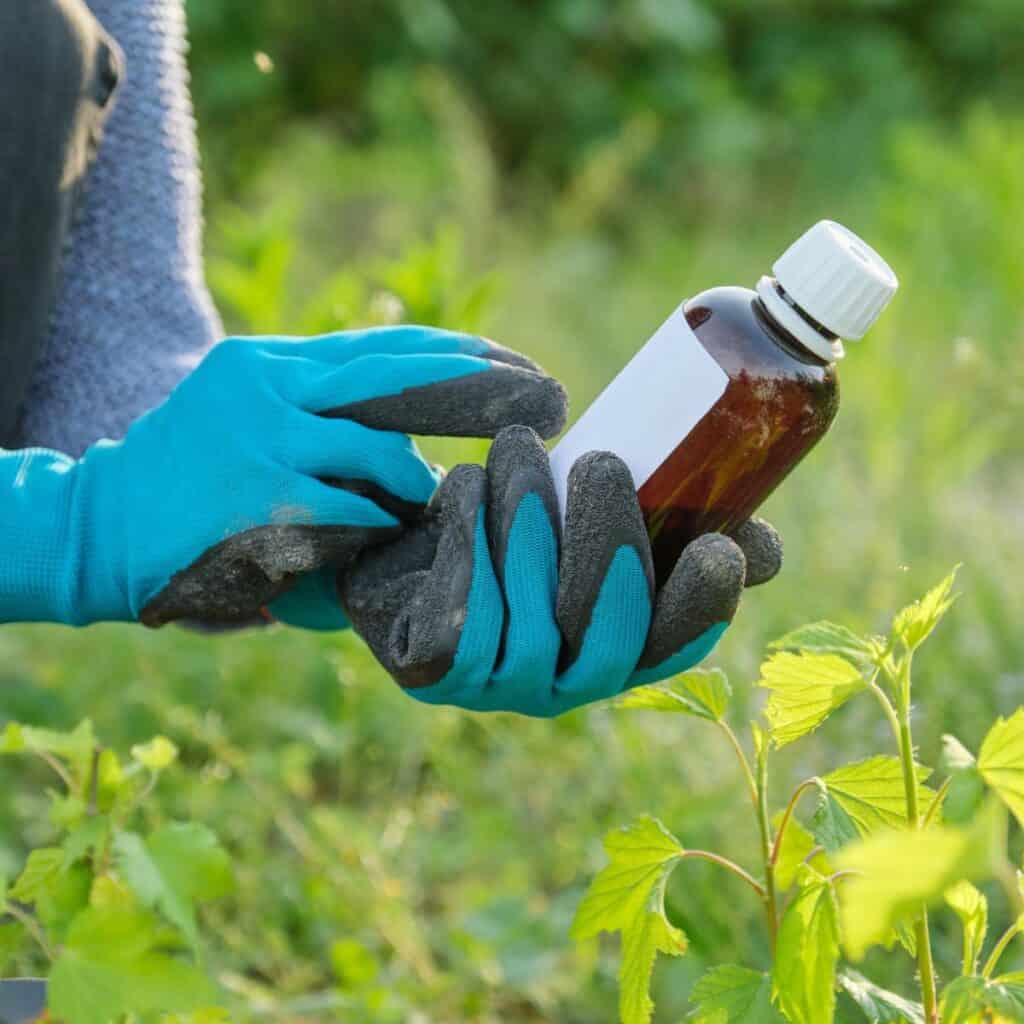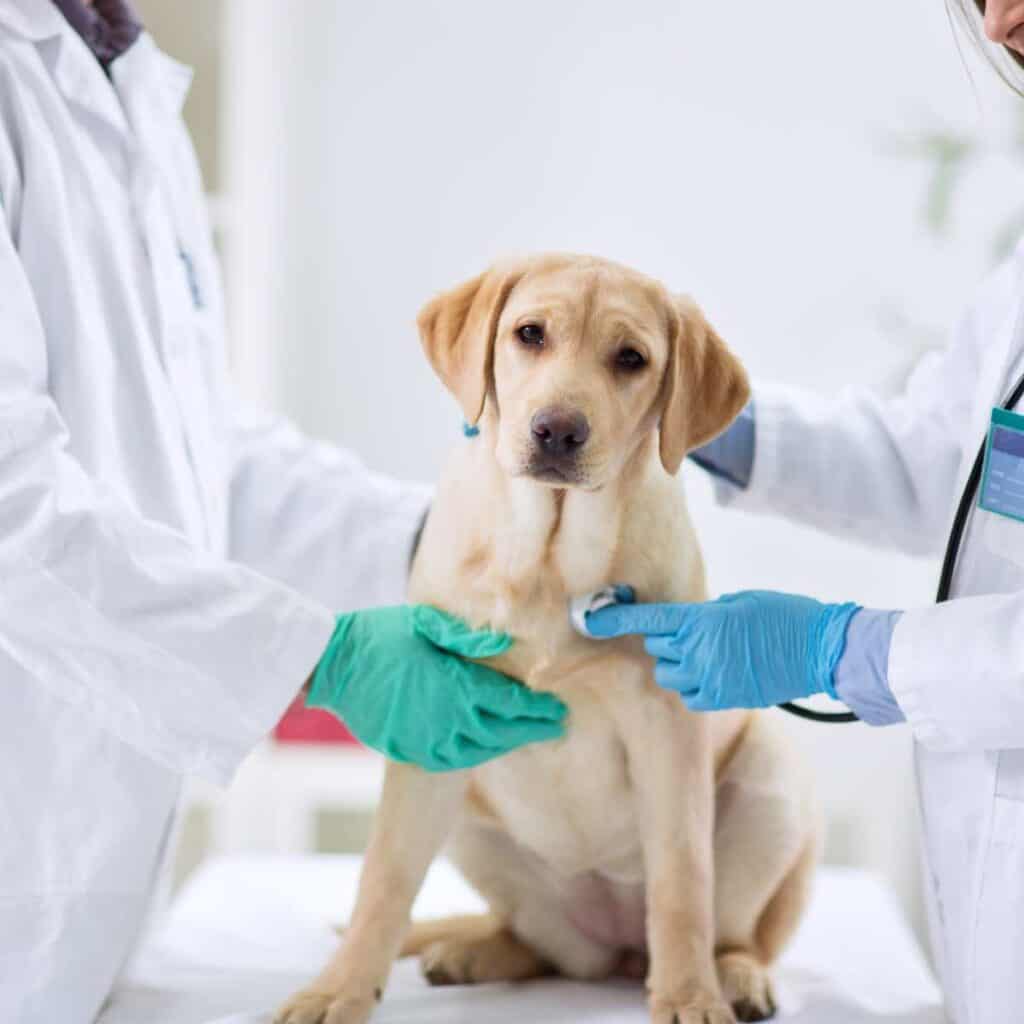Getting lush green grass free of unwanted plants takes a lot of routine maintenance by everyone including dog owners and that maintenance may require using regular lawn chemicals, herbicides, pesticide treatments and lawn fertilizer.

It’s no secret that dogs love playing outside, especially on lush green lawn grass. However, dogs are much closer to the ground and prone to digging, rolling and pesticides, herbicides and lawn fertilizer can be readily absorbed in a dog’s paws, which means dogs are more likely to be exposed to lawn treatment chemicals.

Keeping your pet off the grass after spraying or applying harsh chemicals is one best practice and strategy to keep your dog safe. Learn here how long to keep your pet off of the grass after pesticide.
How Long to Keep Your Dog Off The Grass After Applying Pesticides and other Harsh Chemicals
After applying harsh herbicides or pesticides to your lawn it is recommended to wait as long as 24-72 hours before letting your dog go back on the grass. It is tough to give an exact estimate time since there are so many different pesticide and herbicide brands on the market.
Each pesticide and herbicide will have a package label insert indicating the half life of the chemical. It is best to review the label information and to be on the safer side and keep your dog off of the treated area a bit longer to ensure that your dog doesn’t get a chance to ingest the chemicals or absorb the chemicals into their paws or feet.
The time window to leave your dog off of the grass after pesticide and herbicides are applied to grass also greatly depends on the type of product being applied. The pesticide label may contain more specific instructions. However a good rule of thumb is to keep dogs away from treated grass until the pesticide is completely dry and the yard has been well ventilated.
It is vital to water your grass the next day before bringing your pet out, since many of the pesticide products evaporate with the water. This not only keeps your dog safe from chemicals, but also allows your grass to absorb the nutrients without being disturbed.

Is pesticide and herbicide spray harmful to dogs?
Most pesticides are toxic to dogs and result in short term clinical signs of drooling, nausea, vomiting, and diarrhea. Pesticides should not be used on grass when a dog is present, as this can cause direct poisoning.
It is logical to consider that dogs exposed to environmental chemicals would be at an elevated risk comparative to the human body due to their size and faster aging (see our article on How to Know if Your Dog is a Senior Dog.). In a recent study researchers have actually proved this to be true scientifically.
Dogs as an Indicator Species
In a 2021 study discussed on Beyond Pesticides, journal environmental research, Researchers at North Carolina State University (NC State) and Duke University found that dogs can potentially operate as a sentinel, or indicator, species for environmental contaminate exposure – and subsequent diseases – in humans. This study reveals the impactful nature of environmental contaminants on our pets (similar to bees in our discussion of the importance of bee conservation dogs), so much so that researchers determined that dogs can be an indicator of issues with humans.
The researchers indicated that humans and dogs share over 360 analogous diseases, including various cancers (i.e., testicular, breast cancer, bladder cancer etc.). However, human disease development can remain latent for years, despite environmental pollutant exposure. Dogs have a shorter disease latency period, further reiterating the importance of keeping them safe from environmental contaminants like herbicides and pesticides and protecting them from other harmful dog food and drink ingredients.
Symptoms of Too Much Herbicide or Pesticide Exposure for Dogs
If your dog has come into contact with a very small amount of pesticide, some irritation may occur but might not be a cause for alarm. However, if your dog is showing any immediate symptoms or signs of distress due to ingesting pesticide which, may occur from ingesting pesticide treated grass, it is crucial to get him to the vet as soon as possible. You should see your vet right away if your dog is showing any of these symptoms:
- Vomiting
- Diarrhea
- Breathing heavily or difficulty breathing
- Shivering
- Dehydration
- Chemical burns around the nose, mouth, and paws
- Skin rashes
- Eye irritations
- Respiratory problems

Long Term Herbicide and Pesticide Exposure in Dogs
Pet owners should also take safety precautions to protect their furry friends from long term issues with pesticide and herbicide exposure. Small repeated exposure can result in long term effects and cause for serious concerns.
Your dog’s repeated exposure directly with pesticides themselves or pesticide residue or herbicides may occur with the use of the lawn after pesticide and herbicide application, being too close during application, and licking their paws after running on pesticide or herbicide treated grass.
It is important to consider overall exposure to pesticide and herbicide due to the potential long term effects of such exposure which may include increased risk of cancer, respiratory issues, and other increased risk of health issues associated with pesticide poisoning
What makes pesticides and herbicides dangerous?
Most commercial lawn pesticides and herbicides are packed with powerful dangerous chemicals that help with pest and weed control. They are efficient and deliver outstanding results. Dogs absorb pesticide residues by chewing or eating grass that was treated with pesticides.

Time spent on a lawn treated with toxic pesticides can be dangerous. In addition to having immediate risk of poisoning, many pesticides are linked to cancer in dogs, which is a main cause of death for pets. Also, prolonged chemical exposure might lead to fertility problems in dogs.
Alternatives to Pesticides and Herbicides That Are Safer For Dogs?
There are several organic pesticides and natural weed killers that serve as natural alternatives that work incredibly well on weeds nd bugs without harsh chemicals and the problems of short and longer term health issues for dogs. Some of those include simple DIY ingredients such as plain boiling water, salt vinegar and dish soap and many more.
Avoiding herbicide and pesticide exposure for pets and keeping your yard looking great is not as hard as it seems.
Final thoughts
Dogs love to eat grass, and your furry companion is no different. You can keep your dog off of the lawn for 24-72 hours or as mentioned on the pesticide label. Make sure to wash your dog’s belly and paws regularly, especially if you suspect that it came into contact with treated grass. Your pet might lick the toxic chemicals off its coat and paws ingest them that way. Also, move dog food and water bowls away from the treated lawn and clean out thoroughly after any lawn treatment.
Check out our other articles on Lawn Care and Pets Including:
Ultimate Guide to the Best Lawn Grass for Dogs (Dog Friendly Grass Varieties, Fescue and more plus artificial vs synthetic grass)
7 Ways to Keep Your Lawn Free from Dog Urine Spots
How long to keep dogs off of grass after using pesticides FAQs
Dogs should stay away from pesticides for 24-48 hours, however, it also depends on the type of pesticide. Liquid pesticides applied with a sprayer may dissipate faster while granular applications that sit in the yard until they are dissolved will take longer. The label on the pesticide product will have detailed information.
If your dog does go near pesticides that a lawn was treated with then you need to wash their paws, legs and belly to remove any residue that they may ingest from licking or getting on other surfaces. Watch for signs of pesticide exposure in dogs depending on the type of contact which includes dizziness, vomiting, difficulty breathing.
Pesticides are harmful after they are dry and have completely dissipated into the environment. This is called the half life of the chemical. When that occurs depends on many factors of the actual pesticide so it is good to use a rule of thumb to leave your dog off of pesticide treated grass even after it is dry and usually for 48 hours but always read the directions on pesticide.
Looking to learn more about taking charge of your Dog’s Health? Learn about Pet Testing from The Popular Pets. Now offering pet testing for your the health of your pet and your peace of mind. Learn more about pet testing options.
You may also be interested in the Ultimate Guide to Heartworm
Diatomaceous Earth for Dogs and Cats FAQ
Diatomaceous earth is great for dogs and is safe to ingest and put on their skin, sniffing diatomaceous earth is not a problem but dog owners do need to be careful that dogs do not inhale DE further. The silica in DE can be harmful to dog and cat lungs, especially pets with respiratory issues. The many benefits of DE make it a useful pet wellness tool.
Since DE is an excellent addition to food due to its ability to kill parasites, bind collagen and support a healthy coat and joints, licking DE is not only beneficial but suggested. DE is safe for dogs but dog lovers should get food grade DE to be safe.
Diatomaceous earth will not harm dogs. DE is non-toxic and actually helpful for dogs due to its many wellness attributes. Pet lovers have found many benefits to adding DE to their pet’s food to help support a healthy coat and fend off parasites and on externally to help with fleas and ticks.

